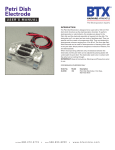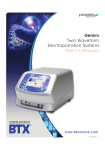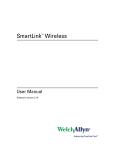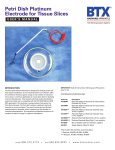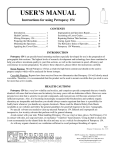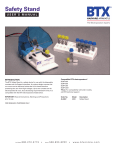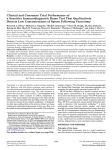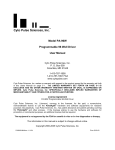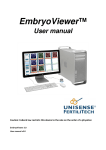Download User`s Manual
Transcript
User’s Manual ECM® 830 Electroporation System 45-0052 45-0052INT ECM® 830 Electroporator only (110 V) ECM® 830 Electroporator only (220 V) Publication 5501-001-REV-E WEEE/RoHS Compliance Statement EU Directives WEEE and RoHS To Our Valued Customers: We are committed to being a good corporate citizen. As part of that commitment, we strive to maintain an environmentally conscious manufacturing operation. The European Union (EU) has enacted two Directives, the first on product recycling (Waste Electrical and Electronic Equipment, WEEE) and the second limiting the use of certain substances (Restriction on the use of Hazardous Substances, RoHS). Over time, these Directives will be implemented in the national laws of each EU Member State. Once the final national regulations have been put into place, recycling will be offered for our products which are within the scope of the WEEE Directive. Products falling under the scope of the WEEE Directive available for sale after August 13, 2005 will be identified with a “wheelie bin” symbol. Two Categories of products covered by the WEEE Directive are currently exempt from the RoHS Directive – Category 8, medical devices (with the exception of implanted or infected products) and Category 9, monitoring and control instruments. Most of our products fall into either Category 8 or 9 and are currently exempt from the RoHS Directive. We will continue to monitor the application of the RoHS Directive to its products and will comply with any changes as they apply. • Do Not Dispose Product with Municipal Waste • Special Collection/Disposal Required ECM ® 830 Electroporation System Table of Contents General Information: Serial Number ................................................................2 Calibration ......................................................................2 Warranty ....................................................................2-3 Service ..........................................................................4 Repair Facilities and Parts ..............................................5 General Safety Summary..............................................6-7 Electrical & Technical Specifications ............................8-9 General Specifications....................................................10 Introduction: Features ........................................................................11 Operation: Getting Started ............................................12 Quick Start: Installation....................................................................13 Connecting ..................................................................13 Initializing ....................................................................13 Instrument Controls ..............................................14-21 Operating Basics ............................................................22 Advanced Operation: Programming ............................23 Electroporation/Electrofusion Theory: Electroporation ............................................................24 Electrofusion ..........................................................24-25 Applications: Electroporation ......................................................26-27 Electrofusion ................................................................27 Appendix A: ECM® 830 Electrode Operation Ranges................................28-29 Appendix B: Optimization Strategies ......................30-31 Appendix C: Electrical Troubleshooting ........................32 Appendix D: Experimental Troubleshooting ................33 Appendix E: Glossary of Electrical Terms ..............34-35 Appendix F: Glossary of Biological & Technical Terms ..............................36-38 Appendix G: Electroporation and Electrofusion Pulse Generator Compatibility ................39 Appendix H: Recommended Reading............................39 Appendix I: Accessories and Replacement Parts ..40-41 Appendix J: General Care and Cleaning ......................42 Appendix K: Footswitch Connection........................43-44 Appendix L: Connecting Electrodes ........................45-50 Page 1 www.btxonline.com ECM ® 830 Electroporation System Table of Contents (continued) Appendix M: Plate Handlers ....................................51-52 ECM® 830 Generator Troubleshooting Guidelines ............................................53-54 Page 2 www.btxonline.com ECM ® 830 Electroporation System General Information Serial Number The serial number for the ECM® 830 is located on the rear of the instrument case. All inquiries concerning these products should refer to the serial numbers on the units. Calibration There is no calibration required for the ECM® 830. Warranty BTX - Harvard Apparatus warranties the ECM® 830 for a period of two years from the date of purchase. At its option, BTX – Harvard Apparatus will repair or replace the unit if it is found to be defective as to workmanship or materials. This warranty does not extend to any instrumentation which has been (a) subjected to misuse, neglect, accident or abuse, (b) repaired or altered by anyone other than BTX - HARVARD APPARATUS without BTX - HARVARD APPARATUS’ express and prior approval, (c) used in violation of instructions furnished by BTX - HARVARD APPARATUS. This warranty extends only to the original customer purchaser. Failure to use the Enhancer 3000 High Voltage probe to connect a BTX Generator to an external digital oscilloscope for monitoring will result in voiding your warranty; connecting directly to the external monitoring equipment or modified monitoring setup will damage the Generator. IN NO EVENT SHALL BTX - HARVARD APPARATUS BE LIABLE FOR INCIDENTAL OR CONSEQUENTIAL DAMAGES. Some states do not allow exclusion or limitation of incidental or consequential damages so the above limitation or exclusion may not apply to you. THERE ARE NO IMPLIED WARRANTIES OF MERCHANTABILITY, OR FITNESS FOR A PARTICULAR USE, OR OF ANY OTHER NATURE. Some states do not allow this limitation on an implied warranty, so the above limitation may not apply to you. Without limiting the generality of the foregoing, BTX - HARVARD APPARATUS shall not be liable for any claims of any kind whatsoever, as to the equipment delivered or for non-delivery of equipment, and whether or not based on negligence. Warranty is void if the ECM® 830 is changed in any way from its original factory design or if repairs are attempted without written authorization by BTX - HARVARD APPARATUS. Warranty is void if parts, connections or cell fusion chambers not manufactured by BTX - HARVARD APPARATUS are used with the ECM® 830. Page 3 www.btxonline.com ECM ® 830 Electroporation System General Information (Continued) If a defect arises within the warranty period, promptly contact BTX – Harvard Apparatus, 84 October Hill Road, Building 7, Holliston, Massachusetts, USA 01746-1388 using our toll free number 1-800-272-2775 (US Only) or 508-893-8999 (E-mail: [email protected]). Goods will not be accepted for return unless an RMA (Returned Materials Authorization) number has been issued by our customer service department. The customer is responsible for shipping charges. Please allow a reasonable period of time for completion of repairs, replacement and return. If the unit is replaced, the replacement unit is covered only for the remainder of the original warranty period dating from the purchase of the original device. This warranty gives you specific rights, and you may also have other rights, which vary from state to state. Service All service under the warranty will be made at the BTX - HARVARD APPARATUS, Holliston, Massachusetts facilities or an authorized service site. Owner will ship instrument prepaid to Holliston, Massachusetts, USA or the service site. BTX - HARVARD APPARATUS will return the instrument after servicing, freight prepaid to owner’s address. Obtaining Service: Service During Warranty 1. Write or call the BTX - HARVARD APPARATUS Customer Support Group and describe the nature of the problem. 2. Carry out minor adjustments or tests as suggested by BTX - HARVARD APPARATUS. 3. If proper performance is not obtained, BTX - HARVARD APPARATUS will notify you to ship the instrument, prepaid, to its Service Department.The instrument will be repaired and returned at no charge for all customers in the continental United States. Customers outside of the continental United States who have purchased our equipment from distributors should contact the distributor. If you have purchased your equipment from us, you should contact us directly. We will repair at no charge, but will not pay for shipment, documentation, etc. These charges will be billed at cost. Note: Under no condition should the instrument or accessories be returned without prior approval from BTX - HARVARD APPARATUS. An RMA (Returned Materials Authorization) number must be obtained. Page 4 www.btxonline.com ECM ® 830 Electroporation System General Information (continued) Out-Of-Warranty Service Proceed exactly as for Warranty Service, above. If our Service Department can assist you by phone or correspondence, we will be glad to, at no charge. Repair service will be billed on the basis of labor and materials. A complete statement of time spent and materials used will be supplied. Shipment to BTX - HARVARD APPARATUS should be prepaid. Your bill will include return shipment freight charges. Disassembly by the user is prohibited. Service should only be carried out by experienced BTX - HARVARD APPARATUS technicians. Repair Facilities and Parts BTX - Harvard Apparatus stocks replacement and repair parts. When ordering, please describe parts as completely as possible, preferably using our part numbers. If practical, enclose a sample or drawing. We offer complete reconditioning service. Page 5 www.btxonline.com ECM ® 830 Electroporation System General Safety Summary Review the following safety precautions to avoid injury and prevent damage to this product or any products connected to it. To avoid potential hazards, use this product only as specified. Only qualified personnel should perform service procedures. To Avoid Fire or Personal Injury USE PROPER POWER CORD Use only the power cord specified for this product and certified for the country of use. CONNECT AND DISCONNECT PROPERLY Do not connect or disconnect probes or test leads while they are connected to a power source. GROUND THE PRODUCT This product is grounded through the grounding conductor of the power cord. To avoid electric shock, the grounding conductor must be connected to earth ground. Before making connections to the output terminals of the product, ensure that the product is properly grounded. OBSERVE ALL TERMINAL RATINGS To avoid fire or shock hazard, observe all ratings and markings on the product. Consult the product manual for further ratings information before making connections to the product. DO NOT OPERATE WITHOUT COVERS Do not operate this product with covers or panels removed. Use Proper Fuse. Use only the fuse type and rating specified for this product. AVOID EXPOSURE TO CIRCUITRY Do not touch exposed connections and components when power is present. DO NOT OPERATE IN LOW IMPEDANCE Sample: Load or Sample If the electroporation samples have an impedance of less than 20 Ω in LV and 40 Ω in HV, the samples may arc and result in sample loss and potential damage to unit. DO NOT OPERATE WITH SUSPECTED FAILURES If you suspect there is damage to this product, have it inspected by qualified BTX service personnel. PROVIDE PROPER VENTILATION Refer to installation instructions for details on installing the product to ensure proper ventilation. Page 6 www.btxonline.com ECM ® 830 Electroporation System General Safety Summary (Continued) DO NOT OPERATE IN WET/DAMP CONDITIONS DO NOT OPERATE IN AN EXPLOSIVE ATMOSPHERE KEEP PRODUCT SURFACES CLEAN AND DRY Should you have any safety concerns, immediately contact BTX Technical Support (1-800-272-2775) Safety Terms and Symbols: Terms that appear in this manual: WARNING. Warning statements identify conditions or practices that could result in injury or loss of life. CAUTION. Caution statements identify conditions or practices that could result in damage to these products or other property. Symbols that may appear on the products: Danger High Voltage Page 7 Attention Refer to Manual Protective (Earth) Terminal Functional Ground www.btxonline.com ECM ® 830 Electroporation System Electrical & Technical Specifications Standard Capabilities: Display Power Source Voltage Power Fusing Type: 20-character by 4-line liquid crystal LED backlit 100 to 240 Vac, 50 to 60 Hz, CAT II Pulse: 500 W Idle: 150 W T2.5 250 V Environmental Characteristics: Intended Use Indoor use only Operating Temperature 10° C to + 40° C Cooling Convection through metal case Relative Humidity 90% relative humidity Altitude 2,000 m (operating) Mechanical Characteristics: Footprint 12.5” x 12.25” x 5.5” (31.75 x 3.12 x 13.97 cm) (W x D x H) Weight 15 lbs (6.8 kg) Controls Single rotary encoder with integrated push button Electrical Characteristics: Voltage 5 to 500 Volts (LV mode) @ 1 Volt resolution 30 to 3000 Volts (HV mode) @ 5 Volts resolution (Voltage Delivery @ 5% accuracy and Voltage Monitoring @ 5.0% accuracy) Pulse Length 10 µs to 999 µs (LV mode) @ 1 µs resolution 1 ms to 999 ms (LV mode) @ 1 ms resolution 1 s to 10s (LV Mode) @ 0.1 s resolution 10 µs to 600 µs (HV mode) @1 µs resolution Page 8 www.btxonline.com ECM ® 830 Electroporation System Electrical & Technical Specifications (Continued) Pulse Interval 100 ms to 10 sec @ 1 ms resolution Multiple Pulsing 1 to 99 pulses Current Limit 500 A limit at 100 µs Pollution Degree 2 Not to be operated in conductive pollutants atmosphere Note: LV Mode Less than a 20% V drop at the end of the pulse with the following constraints: PL ≤ 25 ms, load 3 20 Ω PL ≤ 1 sec, load 3 1k Ω PL ≤ 10 sec, load 3 10k Ω HV Mode Less than a 10% V drop at the end of the pulse with the following constraints: PL ≤ 600 µs, load 3 40 Ω BTX instruments are designed for in vitro and in vivo animal and plant applications only and are not for human Clinic. Page 9 www.btxonline.com ECM ® 830 Electroporation System General Specifications Certifications and Compliances Overvoltage Category: CAT III Products in this Category: Distribution-level mains, fixed installation CAT II: Local-level mains, applications and portable equipment CAT I: Signal levels in special equipment or parts of equipment, telecommunications and electronics Meets requirements of Directive 89/336/EEC for Electromagnetic Compatibility (EC) and Low-Voltage Directive 73/23/EEC for Product Safety. Compliance was demonstrated to the following specifications as listed in the Official Journal of the European Communities: EN 50081-1 Emissions EN 55011 Class B Radiated and Conducted Emissions EN 55082-1 Immunity IEC 10004-2 Electrostatic Discharge Immunity IEC 10004-3 RF Electromagnetic Field Immunity IEC 10004-4 Electrical Fast Transient/Burst Immunity Low Voltage Directive 73/23/EEC EN 61010-1 Safety requirements for electrical equipment for measurement, control and laboratory use. Page 10 www.btxonline.com ECM ® 830 Electroporation System Introduction The ECM® 830 is a square wave electroporation system designed for in vitro and in vivo electroporation applications. BTX square wave technology offers researchers the ability to transfect cells efficiently and with higher cell viabilites. ECM® 830 features include: • • • • • Page 11 A wide range of voltages from 5 to 3000 V Finer voltage discrimination Pulse durations from 10 µsec to 10 sec Arc Quenching Digital display of actual voltage and pulse length delivered www.btxonline.com ECM ® 830 Electroporation System Operation: Getting Started Carefully open the box containing the ECM® 830 Electroporation System. Verify receipt of the following items: ECM® 830 Pulse Generator (1) Power Cord (1) Model 830E Electronic Manual (1) BTX Electroporation Systems may be customized with the addition of various electrodes and accessories. The following items complete a typical system order: Model 630B Electroporation Safety Stand (1) Model 660 Cuvette Rack (1) Model 610 BTX Cuvettes Plus (10) Model 620 BTX Cuvettes Plus (10) Model 640 BTX Cuvettes Plus (10) If you have ordered alternative or different items, please verify their receipt Page 12 www.btxonline.com ECM ® 830 Electroporation System Quick Start Installation 1. Install on a bench or work table. 2. Allow a 1 to 2 inch clearance for proper cooling. It is normal for the instrument to be slightly warmer than its’ operating environment. 3. Choose an outlet that is readily accessible. Connecting 1. Insert female end of power cord into male power interface on the back panel of the ECM® 830. 2. Plug male end of power cord into appropriate electrical outlet. 3. Insert male banana plugs of the 630 B Safety Stand or alternative electrode device into HV output located on front panel of the ECM® 830. Initializing 1. Push the power switch located on the front panel of the ECM® 830. 2. Push the power switch located on the front panel of the ECM® 830. The display will flash: " % #! !% ! ! # ! % ! #$" 3. Following this initialization screen, the first time the instrument is initialized, the factory default display will then read: # # # ! # !" % µ" 4. The first page of the Set Parameter Screen from the last time the ECM® 830 was used will be displayed each time the ECM® 830 is powered up after this initial start up. Page 13 www.btxonline.com ECM ® 830 Electroporation System Quick Start (Continued) Instrument Controls Parameter Control Knob Start Switch Display High Voltage Output ™ Smart Link Power Switch Power Switch 1. Switch located on the lower right front panel. 2. Press once to initialize the ECM® 830 and once more to turn off. Note: A stabilization period of 3 seconds is required after connecting to an outlet. Start Switch 1. The electronic Start Switch on the upper left front panel is activated in the “ready” mode when the parameter set screen is displayed. 2. Once the start switch is activated, the generator will charge the capacitor bank, then “settle” by bleeding off the capacitors to the preset voltage, prior to delivering the pulse. 3. The maximum setting time is 3 seconds. A pulse sequence may be aborted by pressing the start switch a second time before the delivery of the pulse. 4. Following the delivery of a pulse, press the start switch once to deliver another pulse, or press the parameter control knob to return to “ready” mode. Page 14 www.btxonline.com ECM ® 830 Electroporation System Quick Start (Continued) Parameter Control Knob The Parameter Control Knob is a rotary encoder controlling both the parameter (i.e. voltage) and the value of the parameter under control (i.e. 50 volts). The display will indicate which parameter is under control by the presence of an arrow to the left of the parameter. 1. To select a parameter to adjust, rotate the knob until the arrow is to the left of the desired parameter, then push to select. The arrow will move to the right of the value displayed for that parameter. 2. To adjust the value of a parameter under control, rotate the knob clockwise to increase the value and counter clockwise to decrease it. After the values are set under control, push the knob to lock set value and arrow will return to left of parameter under control. 3. In order to move between screens, move the cursor to the bottom of the screen and rotate the knob clockwise to move to the next screen. 4. In order to move to the previous screen, move the cursor to the top of the screen and rotate the knob counterclockwise. Display The ECM® 830 Display will show two possible screens, the Set Parameter Screen and the Pulsing Completed Screen as well as various Status Messages. Set Parameter Screen 1. The Set Parameter Screen is indicated by a display showing “Set Parameters” on the first line of each of three screen pages. 2. The Mode, Voltage and Pulse Length are shown on the first page; the Number of Pulses, Pulsing Interval and Polarity are shown on the second page and the Advanced Features including Save, View and Load are shown on the third and final page of the Set Parameter Screen. 3. The ECM® 830 will beep when toggling from one page to another. Mode The Mode indicates “LV” for low voltage mode or “HV” for high voltage mode. Adjusting the voltage as appropriate automatically controls the mode. There is no manual mode control. Page 15 www.btxonline.com ECM ® 830 Electroporation System Quick Start (Continued) Voltage The Voltage indicates the set voltage in volts. The low voltage mode range is 5 V to 500 V in 1 V increments and the high voltage mode range is 505 V to 3000 V in 5 V increments. A beep is heard when transitioning between LV and HV modes. P. Length 1. Pulse Length indicates the set pulse length in µs or ms. The pulse length minimum is 10 µs in both HV and LV modes. 2. In the LV mode, the maximum pulse length is 10 seconds. The pulse length units change from µs to ms at 1ms and from ms to s at 1s. 3. Refer to Table 1 for HV pulse length maximum limits. To estimate approximate pulse lengths at various voltages in the high voltage mode, refer to Table 1 below. 4. Please note that the voltage determines the maximum pulse length in the HV mode. 5. If the voltage is increased and the pre-set pulse length is longer than the maximum pulse length allowed, the pulse length will automatically adjust to that level. Table 1 HV Mode Voltage 505 750 1000 1500 2000 2500 3000 Page 16 Maximum Pulse Length (µs) 594 400 300 200 150 120 100 www.btxonline.com ECM ® 830 Electroporation System Quick Start (Continued) Figure 2 # Pulses The # Pulses indicates the number of set pulses from 1-99. Interval The Interval indicates the time duration between pulses. The interval range is 100 ms to 10.0 seconds, switching from units of ms to seconds after 999 ms, with 0.1 sec resolution. Advanced Features The final Set Parameters page enables the user to save, view, and load up to three programs. Please note that parameters can be changed inadvertently once a program is loaded. A default program is used to initialize the system. Program 1 is used to automatically store changes in parameters set each time the system is pulsed. Programs #2 and #3 can be used to set and save experimental parameters for instant use. Save 1. To save the current set parameters as a program, push the parameter control knob to move the arrow to the left of the program number. 2. Rotate the knob to designate the appropriate program number, then push and hold the knob in, releasing after a new screen is displayed. 3. The new screen will read “Saved Current Parameters to Set N”. Push the parameter control knob again to return to the setup screen. Page 17 www.btxonline.com ECM ® 830 Electroporation System Quick Start (Continued) View 1. To view the appropriate program parameters, push the parameter control knob to move the arrow to the left of the program number. 2. Select the appropriate program number by rotating the parameter control knob, then hold the knob in, releasing after a new screen is displayed. 3. The new screen will outline the parameters currently stored under that program number. Push the parameter control knob again to return to the setup screen. Load 1. To load a saved program, push the parameter control knob to move the arrow to the left of the program number. Please note that in addition to three available programs, there is also the default program as outlined in the “Initializing” section. 2. Rotate the knob to change the program number. 3. Push and hold the knob in, releasing after a new screen is displayed. The new screen will read “Loaded Set N to Current Parameters”. 4. Push the parameter control knob again to return to the setup screen. On-Line Help In the Set Parameter Mode, an On-Line Help function is enabled. On-Line Help provides a definition for all set parameters and advanced functions. 1. To use On-Line Help, rotate the parameter control knob so that the arrow is to the left of the parameter or feature of interest (not the value of the parameter). 2. Push the parameter control knob in and hold until the definition is displayed. 3. Push a second time to return to the Set Parameter Screen. Mode Low voltage or high voltage range mode Voltage The amplitude of the output pulse P Length The time duration or length of the pulse Page 18 www.btxonline.com ECM ® 830 Electroporation System Quick Start (Continued) # Pulses The number of output pulses Interval The time interval between pulses Save Save current setup parameters to nonvolatile memory View Show the setup parameters stored in nonvolatile memory Load Load setup parameters from memory to use Status Messages Following the initiation of a pulsing sequence, various status messages are displayed. The following status messages may be observed: Charging, Pulsing, Pulse Aborted, and Temperature Failure. Charging As soon as the start switch is pressed, the “Charging” status message is displayed. The capacitors in the ECM® 830 are overcharged during the duration of this message. Pulsing Once the capacitors have reached the preset voltage level, they are discharged and the “Pulsing” status message is displayed for the duration of the pulse or preset number of pulses. A click or a beep will be heard upon the delivery of each pulse. The sound that is heard is a function of the pulse length. At pulse lengths less than 1 to 2 ms, clicks will likely be heard. At pulse lengths at or above 1 to 2 ms beeps should be heard. A final, more extended beep will be heard upon completion of the pulsing sequence. Following the pulsing status message, the Pulsing Completed Screen is displayed. Pulsing Aborted During Charging If the start switch is activated a second time prior to delivery of a pulse, the pulsing sequence is aborted and the “Pulsing Aborted During Charging” status message is displayed. Page 19 www.btxonline.com ECM ® 830 Electroporation System Quick Start (Continued) Temperature Failure If unit is rapidly pulsed at the high end of the two voltage modes, it is possible for a high temperature warning to occur. In this event, the status message observed is “Unit Cooling” “Please Wait”. When the unit has cooled down to a safe level, two beeps will sound and the message will change to “Ready”. Pushing the start button, or rotating the parameter control knob will shift user back to Parameter Set Screen. Pulsing Completed Screen The Pulsing Completed Screen is displayed following the delivery of a pulse or train of pulses and is indicated by the display “Pulsing Completed” on the top line of each of two screen pages. 1. Page 1 comes up automatically; rotate the parameter control knob clockwise to view page 2 and counter clockwise to go back to page 1. 2. Press the knob to return to the Set Parameters Screen or press the start switch to deliver another pulse. The pulsing completed screen displays monitored parameters including Mode, Voltage, Pulse Length, Number of Pulses, Pulse Interval and Polarity. Please note that parameters will be displayed, even if Safety Stand or other output is not connected. Always verify that your sample is connected with the HV output. Mode Mode indicates the voltage mode used in the delivery of the last pulse: LV or HV. Voltage Voltage indicates the output voltage of the last pulse, in volts. For pulses of 10 to 255 µs, the voltage is measured at the end of the pulse, and for pulses longer than 255 µs, the voltage is measured at the beginning, or peak. P Length P Length indicates the duration of the pulse in µseconds from 10 to 999 µs, mseconds from 001 to 999 ms, or in seconds from 1.0 to 10.0 s. # Pulses # Pulses delivered in the last pulsing sequence is displayed, from 1 to 99. Page 20 www.btxonline.com ECM ® 830 Electroporation System Quick Start (Continued) Interval The Interval between the next-to-last and the last pulse is monitored and displayed in ms from 100 to 999 ms and in seconds from 1.0 to 10.0 seconds. If only one pulse is delivered, “none” is displayed. Polarity The Polarity used in the last sequence of pulses is monitored and displayed as Unipolar. To reverse the polarity manually, simply switch the + (positive) and - (negative) leads from the safety stand. High Voltage Output The High Voltage Output is located in the lower center portion of the front panel. Plug the high voltage cables into this output following the color-coded polarity. SmartLink™ The Smartlink™ port on v1.08 ECM® 830 and beyond is equipped with footswitch connection capabilities. If your instrument falls in this category and you wish to use the footswitch, please see appendix K on page 44. If you are using an older model ECM® 830, you may not have the ability to use a footswitch or your unit may be upgraded for this accessory, contact BTX Technical Support at 1-800-272-2775 or [email protected] for assistance. Page 21 www.btxonline.com ECM ® 830 Electroporation System Operating Basics USE WITH SAFETY STAND AND BTX DISPOSABLE ELECTROPORATION CUVETTES PLUS 1. Insert the safety stand banana plugs into the HV Output on the front panel of the ECM® 830. 2. Press the power switch to initialize the ECM® 830. 3. Rotate parameter control knob to move arrow to voltage and push to select. Rotate knob to adjust voltage. Push again to select that voltage. 4. Rotate parameter control knob to move arrow to P 630B 45-0207 Length and push to select. Rotate knob to adjust pulse length. Push again to select that pulse length. 5. Rotate parameter control knob to move arrow to # Pulses (Page 2) and push to select. Rotate knob to adjust the number of pulses. Push again to select that number of pulses. 6. Rotate parameter control knob to move arrow to Interval if you have designated more than one pulse in 5 and push to select. Rotate knob to adjust the pulse interval. Push again to select that pulse interval. 7. Prepare sample, pipette into the appropriate BTX Disposable Cuvettes Plus, place the cuvette in the 630B Safety Stand and secure the safety cover. 8. Press the Start button. The ECM® 830 will charge and then deliver the electroporation pulse or train of pulses selected, beeping with the delivery of each pulse. 9. Process sample. Do not forget to record appropriate parameters as displayed on the Pulsing Completed Screens, for documentation purposes. 10. To return to “ready” mode, press the Start button. 11. To abort a pulse before delivery, press the Start button during the “charging” mode. Use with Alternative Electrode Chambers and Applicators The ECM® 830 may be used to power all BTX electroporation and electrofusion chambers and applicators. Follow the above instructions in conjunction with instructions provided for the specific electrode. Refer to Appendix A for graphical representation of operating ranges of various chambers and applicators with the ECM® 830. Use with Footswitch. Please see Appendix K on page 44. Page 22 www.btxonline.com ECM ® 830 Electroporation System Advanced Operation: Programming 1. Set parameters as outlined in Operating Basics. 2. Once presetting of parameters has been completed, rotate the parameter control knob until the save function has been reached. 3. Press knob in and release. Now rotate to select which program number the chosen settings (see “Preset Parameters” above) should be saved under. Program #1 is reserved for current parameters in active use and cannot be used for pre-set storage. 4. Push and hold knob in, releasing only after a new screen reading “Saved Current Parameters to Set N” is displayed. (N refers to program number designated in step 2) 5. Push the parameter control knob again to return to the Set Parameter Screen. 6. From the Set Parameter Screen, use the parameter control knob to rotate until the load function has been reached. 7. Push the knob in and release. Now rotate to select the appropriate program number. 8. Push and hold knob in, releasing only after a new screen. Page 23 www.btxonline.com ECM ® 830 Electroporation System Electroporation/Electrofusion Theory Electroporation Electroporation is the application of controlled, pulsed electric fields to biological systems. If the biological system contains a lipid bilayer, such as is the case if the system is a suspension of cells or liposomes, the pulsed electric field may overcome the field potential of the lipid bilayer, resulting in a reversible breakdown of the bilayer and a resulting formation of temporal pores in the membrane. The pores formed are of the order of 40 to 120 nm. Most pores reseal within a few seconds, after allowing the transfer of materials into and out of the cells. During a typical electroporation process, target cells and molecules are mixed together. When an electroporation pulse is delivered, the result is the formation of temporal pores. Before the pores reseal, the target molecules are observed to enter the cells. Upon resealing of the pores, the molecules become incorporated within the cell. The eventual target site depends on the application; for example, molecules can remain in the cytoplasm, interact with the membrane, and move into the nucleus. Applications for electroporation include permeabilization of virtually all cells to a wide variety of molecules and ions. The most common applications for electroporation are the transformation or transfection of cells with DNA or RNA. Other applications for electroporation include electroactivation, electroinsertion of proteins into cell membranes and electroextraction of molecules from cells. Although electroporation has mainly been used as a research tool, recent work has demonstrated its potential for clinical applications. Some areas being explored include: • electrochemotherapy which involves electroporation for delivering chemotherapeutic agents directly to tumor cells • encapsulation of drugs/genes into cells for their use as carrier systems • transdermal delivery of drugs/genes • gene therapy and delivery of drugs/genes with an electroporation catheter. Pore Formation Electroporation Process Electrofusion Cell or protoplast fusion may occur during the electroporation process, if the cells/protoplasts are brought into physical contact prior to the delivery of the pulsed electric field. In the electrofusion process, cells/protoplasts may be brought into contact through an alternating current (AC) alignment. The AC current is only available on the ECM® 2001. ECM® 830 fusion users would be required to manually align the cells. The AC Electric Field Diagram Page 24 www.btxonline.com ECM ® 830 Electroporation System Electroporation/Electrofusion Theory (Continued) current causes a dielectrophoresis, which may result in the formation of pearl chains of cells/protoplasts. After delivery of the direct current (DC) pulse, pores that have been formed in close juxtaposition may reseal upon one another. If the process results in an intact hybrid, electrofusion has occurred. Commonly, a second round of AC alignment is employed following resealing, in an attempt to “compress” or stabilize the hybrid, and increasing the efficiency of the process. Applications for electrofusion include: animal cloning, animal nuclear transfer, animal embryo manipulation, hybridoma formation, and transgenic plant production. Electroporation and electrofusion generators can be characterized by waveform. BTX exponential decay waveform generators, such as the BTX ECM® 600, ECM® 399, ECM® 395 and T720 deliver an exponentially decaying pulse. The length of such a discharge waveform is commonly characterized by the time required for the initial voltage to decay to 1/e (roughly 1/3) of the initial value. To achieve a desired pulse length, appropriate resistance and capacitance must be selected on the instrument. Voltage may be directly set on the instrument. Square waveform generators, such as the ECM® 830, BTX T820 and ECM® 2001 deliver square wave pulses of fixed pulse length, which may be directly adjusted on the instrument. The square wave pulse is produced by a partial discharge of a large capacitor, which requires the interruption of high currents against high voltages. Typically, voltage, pulse length, and number of pulses are all directly set on the instrument. Square wave pulses have well defined electric field amplitude, are both effective and also relatively mild to cells to yield higher viability. Alternating current generators, such as the BTX ECM® 2001, and radio frequency (RF) generators deliver a sinusoidal wave, and are used to cause dielectrophoresis, in which cells may be brought together for fusion. Parameters, which typically may be set include amplitude, duration, and frequency. Page 25 Exponential Decay Wave square wave Alternating Current www.btxonline.com ECM ® 830 Electroporation System Applications Electroporation Bacteria and Yeast Electroporation The most common application is transformation. Field strength and pulse length are critical parameters for reporting, optimization and troubleshooting bacterial and yeast applications. Mammalian Cell Electroporation Electroporation has been used successfully to introduce many different molecule types into cells. Most commonly, electroporation is used for the processes of transfection, in which nucleic acid (DNA and RNA), is introduced into cells. Electroporation can be used to deliver oligonucleotides into cells for siRNA or Gene Silencing anti-sense applications. It can be used to deliver proteins into cells, even large enzymes such as restriction enzymes and antibodies, for various purposes. Peptides have also been electroincorporated. Smaller molecules have been incorporated into cells and liposomes, such as dyes, sugars and dNTP’S. Electroporation has been used to study cellular activation processes, by electropermeabilizing cells to Ca2+, Mg2+ and Na+. Electroporation is also used to electroinsert proteins into the cell membrane. Finally, electroporation has been used to introduce drugs, such as the chemotherapeutic agent bleomycin, into cancer cells, in vitro and in vivo. The use of low impedance buffers such as PBS may result in a voltage drop so that the actual peak voltage delivered to samples may be less than the set voltage. With exponential decay generators, monitoring is necessary to identify the pulse length, or time constant, since this parameter may be very much dependent on the impedance of the sample (sample load). When using complex and custom electroporation applicators and chambers, the electroporation waveform may be altered and monitoring is again strongly recommended. High GFP expression in Mouse PE501 Plant Protoplast Electroporation Electroporation has been used to introduce molecules into plant protoplasts, pollen and most recently, direct transfer into plant tissue (in vivo). Other Electroporation Applications 1. Transgene incorporation, in which simple transfection of fish embryos has resulted in transgenic zebrafish. Plant Protoplast 2. Utilization of sperm as biological DNA carriers, in which pulsed fields cause the complexing of DNA to sperm, which then act as carriers upon fertilization. Page 26 www.btxonline.com ECM ® 830 Electroporation System Applications (Continued) 3. Acrosome enhancement in which an exponential decay pulse enhances the acrosome reaction and facilitates fertilization. 4. Embryonic Stem Cell Chimeras, in which embryonic stem cell transfection, followed by micromanipulation into host blastomere, has resulted in chimeric mice. 5. Parthogenesis, in which a repetitive DC pulse stimulates an unfertilized egg to activate and divide as if fertilized, resulting in haploid and diploid embryos. Electrofusion Embryo Manipulation Embryo Manipulation includes nuclear transplantation experiments, in which blastomeres are inserted by micromanipulation through the zona pellucida into the perivitelline space of a surrogate enucleated egg. After application of an AC wave to facilitate compression and alignment, a single DC square wave fuses the pair and subsequent pulses activate the resulting nuclear transplant embryo. Hybridoma Formation Electrofusion has been used by researchers as a replacement for polyethylene glycol (PEG), in the production of monoclonal antibodies by hybridomas. Microelectrofusion of hybridomas is used to generate hybrid hybridomas, or quadromas, secreting bifunctional antibodies, without the use of drug selection markers, resulting in higher yields than PEG without the delays of drug selection. Plant Protoplast Fusion The process of electrofusion has been used extensively to fuse plant protoplasts, resulting in viable hybrid offspring. Other Electrofusion Applications Electrofusion has been used for the fusion of yeast and bacteria cells. Page 27 www.btxonline.com ECM ® 830 Electroporation System Appendix A: ECM® 830 Electrode Operation Ranges Figures 1 to 5 display expected operating ranges for the ECM® 830 with various chambers and electrodes. The data lines in the following figures represent the arcing boundaries for the given electrode/chamber model, electroporation media, volume, and voltage/mode. The area at and above each line represents 100% arcing probability, with the result that the ECM® 830 will detect and quench the pulse. The area beneath each line represents parameters that will lead to the delivery of a full pulse. This data was empirically determined in the BTX Validation Laboratory. 4 mm gap cuvette 10 to 350 V 10 µsec to 70 msec Figure 1 Operating Range for the ECM® 830 with 640 in LV with PBS at various volumes 2 mm gap cuvette 10 to 300 V 10 µsec to 70 msec Figure 2 Operating Range for the ECM® 830 with 620 in LV with PBS at various volumes Page 28 www.btxonline.com ECM ® 830 Electroporation System Appendix A: ECM® 830 Electrode Operation Ranges (Continued) 1 mm gap cuvette 10 to 300 V 10 µsec to 70 msec (µs) Figure 3 Operating Range for the ECM® 830 with 610 in LV with PBS at various volumes Petri dish electrode 10 to 300 V 10 µsec to 7 msec Figure 4 Operating Range for the ECM® 830 with 366 in LV with PBS at various volumes Petri dish electrode 10 to 400 V 10 µsec to 7 msec Figure 5 Operating Range for the ECM® 830 with PP35-2 in LV with PBS at various volumes Page 29 www.btxonline.com ECM ® 830 Electroporation System Appendix B: Optimization Strategies General The success of electro cell manipulation (ECM) lies in selecting appropriate ECM systems capable of delivering the pulses suitable for the cell being electromanipulated. One, or several pulses of the appropriate field strength, pulse length, and wave shape may be required for this purpose. The key to success with electroporation-based technologies involves a proper combination of biological, physical, chemical, and pulse parameters. In general, cells must be in mid-logarithmic growth for optimal electroporation. Various temperature regimens have been described. It has been shown that a variety of chemical techniques may increase electroporation and electrofusion efficiencies, including addition of EDTA, DMSO, intracellular salts, and serum before or after the pulse. Optimizing protocols abound. Analysis of these optimization regimens has lead to proposals of universal protocols, involving very limited optimization over a narrow range. Electroporation 1. Vary the voltage in order to vary the field strength, keeping other parameters constant. Assay sample for both viability and endpoint. Plot the field strength versus both viability and endpoint and extrapolate the optimal field strength (voltage divided by gap size) and voltage. 2. Vary the capacitance/resistance/sample volume at the optimal voltage setting in order to vary the pulse length (time constant) for exponential decay instruments. Directly vary square wave instrument pulse length. Assay sample for both viability and endpoint. Plot the pulse length versus both viability and endpoint and extrapolate the optimal pulse length/parameters. 3. For multiple pulsing systems/protocols, vary the number of pulses at the optimal field strength and pulse length. Assay sample for both viability and endpoint. Plot the number of pulses versus both viability and endpoint, and extrapolate the optimal number of pulses. Page 30 www.btxonline.com ECM ® 830 Electroporation System Appendix B: Optimization Strategies (Continued) Electrofusion DC Fusion 1. Vary the voltage in order to vary the field strength kv/cm, keeping other parameters constant. Assay sample for both viability and fusion efficiency. Plot the field strength versus both viability and endpoint and extrapolate the optimal field strength (voltage divided by gap size) and voltage. 2. Vary the square wave instrument pulse length. Assay sample for both viability and endpoint. Plot the pulse length versus both viability and fusion efficiency and extrapolate the optimal pulse length/parameters. 3. For multiple pulsing systems/protocols, vary the number of pulses at the optimal field strength kv/cm and pulse length. Assay sample for both viability and fusion efficiency. Plot the number of pulses versus both viability and endpoint, and extrapolate the optimal number of pulses.. Page 31 www.btxonline.com ECM ® 830 Electroporation System Appendix C: Electrical Troubleshooting Instrument Does Not Power Up Verify that the power cord is fully inserted in the instrument and in the wall outlet. Verify that the fuse is not blown. Disconnect power cord from the instrument before removing the fuse holder. Replace the fuse, if necessary, with same rated fuse as indicated on back panel. LCD Error Messages The ECM® 830 is constantly monitoring the parameters of some of its internal circuitry. In the case of a malfunction, one of the following messages will appear on the display. Note the instructions on the following page. EEPROM Failure The unit has detected a malfunction in its internal memory system. The validity of the data might be compromised. Turning or pressing the knob will bring the Set Parameters screen. Verify carefully every setpoint before pulsing. This verification is performed during power up and every time that data is loaded from memory. Contact BTX Technical Support if this error message is displayed again, after a power up sequence. Pulsing Aborted Charging Timed Out A charging time limit of 20 seconds is provided for circuit safety. If the capacitors are not charged to the pre-set voltage level after 20 seconds, the “PULSING ABORTED CHARGING TIMED OUT” message is displayed. For assistance with this situation, please contact BTX Technical Support. Press the encoder or the pulse switch once to get back to the Set Parameters screen. Page 32 www.btxonline.com ECM ® 830 Electroporation System Appendix D: Experimental Troubleshooting Arcing Verify electrical component functionality. Verify properties of cell sample (do cells need to be washed? Is the buffer appropriate for application?). Verify properties of transfectant/molecule (s the DNA well purified?) Try reducing the voltage or increase sample volume until arcing is no longer a problem. Low (or no) transfection efficiency, or incorporation Verify physical, biological, and chemical parameters. Verify delivery of the pulse and pulse parameters. Is the voltage correct? Chamber gap? Pulse length or appropriate instrument settings? Number of pulses? If so, follow Optimization Guidelines outlined in Appendix A. Low viability Verify physical, biological, and chemical parameters. Are the voltage, chamber gap, pulse length (time constant), pulse number and other instrument settings correct? If so, reduce voltage, pulse length, or number of pulses and re-optimize protocol to improve viability as outlined in Appendix A. Low fusion yield Verify physical, biological, and chemical parameters. Troubleshoot alignment as outlined in above. Verify delivery of DC fusion pulse, voltage, field strength, and pulse length. Re-optimize DC fusion parameters as outlined in Appendix A. Monitoring of Non-Rectangular Pulse Waveforms The ECM® 830 has been designed to deliver rectangular wave forms under the most common range of experimental conditions. If the Enhancer® 3000 or an alternative oscilloscope is used to monitor the waveform, non-rectangular pulses may be monitored under conditions of very low or very high sample impedance. For additional information, please contact BTX Technical Support. Voltage Drop A drop in output voltage accompanies pulse delivery into highly conductive samples (for example, PBS). Thus the displayed voltage may in these situations be less than that expected, given 5% full scale accuracy and the monitoring accuracy of 5%. In addition, for very short pulses (255 ms or less) the ECM® 830 measures the voltage at the end of the pulse. Thus for non-rectangular waveforms, a difference between the set and actual voltages may be observed. Page 33 www.btxonline.com ECM ® 830 Electroporation System Appendix E: Glossary of Electrical Terms Alternating Current (AC) (EMC® 2001 only) Current whose amplitude varies with time as defined by its frequency. Used to induce a divergent electric field, allowing for dielectrophoresis. Alternating currents are used to achieve dimer formations/pearl chains before DC pulse is applied for the fusion process. Amplitude The instantaneous value of current or voltage in amperes or volts. Capacitor A device that stores electric energy in the form of an internal electric field. Energy is delivered when a current flows out of a capacitor. The current normally follows an exponential curve. Dielectric A material that has a high resistivity and can store energy in the form of an electric field. Direct Current (DC) Current whose amplitude is constant with time. Direct currents are used to form temporary pores in bi-lipid membranes. Cells may fuse when pores in the membranes of two juxtaposed cells reseal after a DC application. Divergence The deviation of electric field lines from a parallel homogeneous condition. A highly divergent field has field lines that rapidly change amplitude (or strength) and direction in the area of interest. Electric Field The electric potential difference between two points divided by the distance separating those points. Expressed in volt/cm. Electric Field Force The mechanical force acting on any electric charge when placed in an electric field. Exponential Decay Non linear waveform typical of capacitor charge and discharge currents and voltages. The exponential decay waveform is characterized by its time constant, the time it takes the voltage to decay to 1/e of the peak voltage. -----1/e Field Strength See Electric Field. Page 34 www.btxonline.com ECM ® 830 Electroporation System Appendix E: Glossary of Electrical Terms (Continued) Frequency The number of times an oscillation goes through a complete cycle in one second. The unit is either cycle/sec or hertz (Hz). Homogenous Electric Field An electric field where the direction and strength of the field lines are constant. Page 35 www.btxonline.com ECM ® 830 Electroporation System Appendix F: Glossary of Biological & Technical Terms Alignment See also Dielectrophoresis and Pearl Chain. A consequence of cells being exposed to an inhomogeneous or divergent electric field, resulting in their movement toward the electrodes, and subsequent alignment or pearl chain formation. Chambers Electroporation and Electrofusion Chambers are the devices used to hold the cells/molecules to be fused/transfected. Cloning In terms of applications for electro cell fusion, cloning refers to the ability to generate identical, viable animals, through processes such as nuclear transplantation. Compression Disposable Electroporation Cuvettes Plus™ See Alignment, Dielectrophoresis, and Pearl Chains. The result of an AC alignment. Dielectric Breakdown The reversible breakdown of lipid bilayer membranes as a result of the application of a DC electroporation pulse. Sufficiently high field strength may increase the membrane potential past a critical point leading to the breakdown of the membrane. Dielectrophoresis See Alignment. Dimer Formation The bringing together of 2 cells, through the process of dielectrophoresis, so they may be fused, resulting in a hybrid. Refer also to Pearl Chain. Electrofusion (EF) or Electro Cell Fusion (ECF) Electric field induced cell fusion. A novel physical means to bond two cells together by applying a high intensity electric field pulse. The use of electroporation to incorporate molecules, or ions, into cells, protoplasts, or liposomes. Dimer Formation Electroinsertion The use of electroporation to insert molecules into lipid bilayer membranes. Electropermeabilization The use of electroporation to make cells, protoplasts, or liposomes permeable to ions and small molecules in their extracellular environment. Page 36 www.btxonline.com ECM ® 830 Electroporation System Appendix F: Glossary of Biological & Technical Terms (Continued) Electroporation The application of high electric field pulses of short duration to create temporary pores (holes) in the membranes of cells. Embryo Manipulation The cloning of animals can be accomplished through embryo manipulation techniques, such as nuclear transfer and electrofusion. Hybrid A viable daughter cell resulting from the fusion of two parent cells. Hybridoma The fusion of an antibody-producing cell with an immortalized cell, resulting in an immortalized hybrid cell capable of generating antibodies. Hydrostatic Pressure The pressure in liquids at rest. Lipid Bilayer An assembly of lipid and protein molecules held together by non-covalent interactions. All biological membranes share this common structure. Osmotic Pressure The applied pressure required to prevent the flow of solvents of different concentration across a semipermeable membrane. Pearl Chains See Alignment and Dielectrophoresis. Chains of cells or vesicles brought into alignment during electro cell fusion, prior to electroporation. Pore A small, mostly transient, opening in a cell wall caused by the application of a brief high electric field pulse. Pressure Gradient The difference in pressure between two points in a medium. Protoplasts The plant cell proper, with the cellulose cell wall removed. Relaxation Time The time a system requires to reach equilibrium. Page 37 www.btxonline.com ECM ® 830 Electroporation System Appendix F: Glossary of Biological & Technical Terms (Continued) Rounding Off The phenomenon of cells forming a sphere after being fused together. Transfection The introduction of nucleic acids into animal cells. Stable transfections result in integration of nucleic acids into host chromosomes and the inheritance of associated traits in progeny cells. Transient transfections result in temporary expression of exogenous nucleic acids. Transformation The introduction of nucleic acids into microorganisms and plant cells. Turgor Pressure The pressure in capillaries. Page 38 www.btxonline.com ECM ® 830 Electroporation System Appendix G: Electroporation and Electrofusion Pulse Generator Compatibility Certain components of BTX® Electroporation and Electrofusion Systems are compatible with components of competitive systems. Please contact BTX Technical Support for details. Appendix H: Recommended Reading Eberhard Neumann, Editor, Electroporation and Electrofusion in Cell Biology, Plenum Publishing Corporation, 1989 Michael Kriegler, Gene Transfer and Expression, A Laboratory Manual, Stockton Press, 1990 Donald Chang, Editor-in-Chief, Guide to Electroporation and Electrofusion, Academic Press, 1992 Jac A. Nickoloff, Editor, Electroporation Protocols for Microorganisms, in Methods in Molecular Biology, Vol 47, Humana Press, 1995 Jac A. Nickoloff, Editor, Animal Cell Electroporation and Electrofusion Protocols, in Methods in Molecular Biology, Vol 48, Humana Press, 1995 Jac A. Nickoloff, Editor, Plant Cell Electroporation and Electrofusion Protocols, in Methods in Molecular Biology, Vol 55, Humana Press, 1995 For further references regarding specific applications and optimization, please contact BTX Technical Support: BTX-Division of Harvard Apparatus 84 October Hill Road Hollistion, MA 01746 Phone: 1-508-893-8999 Toll Free: 1-800-272-2775 Fax: 1-508-429-5732 Email: [email protected] Website: www.btxonline.com Page 39 www.btxonline.com ECM ® 830 Electroporation System Appendix I: Accessories and Replacement Parts Catalog No. Model Description 45-0002 45-0124 8300 830 630B 610 45-0125 620 45-0126 640 45-0211 1250F ECM® 830 Electroporation System ECM® 830 Electroporator only Electroporation Safety Stand Disposable Electroporation Cuvettes Plus, 1mm, 50 per bag Disposable Electroporation Cuvettes Plus, 2 mm, 50 per bag Disposable Electroporation Cuvettes Plus, 4 mm, 50 per bag BTX Generator Footswitch Adapter Set, Banana-to-Minigrabber Adapter Set, Banana Splice, F/F Adapter Set, Banana-to-Square Post Cables Adapter Set, Banana-to-Pin Tip, F/F Safety Stand Enhancer 3000® Electroporation Monitoring System Petri Dish Electrode, 2 mm Gap Caliper Electrode, 1 x 1 cm, Brass Caliper Electrode, 1.5 x 1.5 cm & 2 x 2 cm, Stainless Steel Microslide, 0.5 mm Gap Microslide, 1.0 mm Gap Microslide, 3.2 mm Gap Microslide, 10 mm Gap Meander Fusion Chamber Flat Electrode, 1mm Gap Flatpack Chamber, 1.83 mm Gap Flatpack Chamber, 0.56 mm Gap Genetrode, Straight, 5 mm Genetrode, Straight, 10 mm Genetrode, Bent, L-Shaped, 5 mm Genetrode, Bent, L-Shaped, 3 mm Genetrode, Bent, L-Shaped, 1 mm Tweezertrode Electrode, 7 mm diameter Tweezertrode Electrode, 10 mm diameter Genepaddles, 3 x 5 mm 45-0052 45-0207 45-0087 45-0088 45-0089 45-0090 45-0207 45-0059 45-0100 45-0101 45-0102 45-0103 630B Enhancer 3000® 366 384 384L 45-0118 450 450-1 453 453-10 454 484 485 486 508 510 512 514 516 520 45-0119 522 45-0122 542 45-0104 45-0105 45-0106 45-0107 45-0108 45-0109 45-0110 45-0113 45-0114 45-0115 45-0116 45-0117 Page 40 www.btxonline.com ECM ® 830 Electroporation System Appendix I: Accessories and Replacement Parts (continued) 45-0123 45-0124 45-0125 45-0400 45-0401 45-0450 45-0452 45-0463 45-0462 45-0465 45-0466 45-0467 Page 41 543 610 620 HT100 HT200 HT-P96-2 Genepaddles, 5 x 7 mm Cuvette, 1 mm Gap, pkg. 50 Cuvette, 2 mm Gap, pkg. 50 Manual 96-Well Plate Handler Automatic 96-Well Plate Handler Disposable 96-Well Plate 2mm gap HT-P96-4 96-Well Disposable Plate 4mm HT-P25-P4 25-Well Disposable Plate 4mm pkg 6 HT-P25-4 25-Well Disposable Plate 4mm 25 Well-Adapter HT HT-P25-2 25-Well Disposable plate 2mm gap HT-P25-2P 25-Well Disposable Plates 2mm gap pkg 6 www.btxonline.com ECM ® 830 Electroporation System Appendix J: General Care and Cleaning General Care Do not store or leave the instrument where the LCD display will be exposed to direct sunlight for long periods of time. CAUTION To avoid damage to the instrument, do not expose to sprays, liquids, or solvents. Cleaning Inspect the instrument, as often as operating conditions require. To clean the instrument exterior, perform the following steps: 1. Remove loose dust on the outside of the instrument with a lint-free cloth. Use care to avoid scratching the clear plastic display filter. 2. Use a soft cloth dampened with water to clean the instrument. Use an aqueous solution of 75% isopropyl alcohol for more efficient cleaning. CAUTION To avoid damage to the surface of the instrument, do not use any abrasive or chemical cleaning agents. Use caution not to drop or cause any unwarranted physical harm to the instrument during any cleaning operations. Page 42 www.btxonline.com ECM ® 830 Electroporation System Appendix K: Footswitch Connection ECM 830 Footswitch Compatibility To determine if your instrument is compatible with a footswitch, please locate the serial number on the rear panel of the generator. If the serial number is 8310249 or sequentially higher than this number, the unit is compatible with a footswitch. If the serial number is 8310248 or sequential lower than this number, than the unit is not compatible with a footswitch. BTX Generator Footswitch Model 1250 FS Instruction Sheet Footswitch 45-0211 Background Information The BTX Generator Footswitch designed for used with BTX ECM 830 Square Wave Generator. Versions 1.08 and beyond have software that support the footswitch operation, so no further modification of the generator is required. If you have a version prior to V1.08, please contact BTX Customer Service at 1-800-272-2775 or [email protected] for further instructions. Please have the instrument serial number (on the back panel) ready to expedite the process. ® Technical Specifications Environmental Intended Use Indoor use only Operating Temperature 0°C to + 40°C Storage Temperature -25ºC to 60ºC Operating Humidity 30 to 75% relative humidity Storage Humidity 10 to 100% (non-condensing) Atmospheric Pressure 0 to 700 kPa Mechanical Footprint 4.5” x 3.5” x 2” (W x D x H) Weight < 2 lbs Cord Length 10 ft www.btxonline.com www.btxonline.com ECM ® 830 Electroporation System Appendix K: Footswitch Connection (continued) Operation Procedure The BTX Generator Footswitch is designed to allow hands-free operation of the generator. Connect the footswitch to the SmartLinkTM port on the front panel of the ECM® 830. Make sure the orientation of the connector on the footswitch cable matches that of the SmartLinkTM orientation. (The flat side of the connector head should face left.) Lay the footswitch flat on the floor close to where the operator will stand. The footswitch functions identical to the Start button on the front panel of the instrument. Once all the parameters are set, simply press the footswitch or Start button to activate pulse delivery or abort a pulse sequence. Safety and Precaution The BTX Generator Footswitch complies with EC Safety Directive, EN61010-1:1993+A2:95. • Avoid water on the floor which could cause the operator to slip when applying pressure to the footswitch. • Keep hands clear of footswitch during operation to avoid pinching the fingers. Warranty ALL BTX accessories are under 90 day warranty period for regular tear and wear. BTX will correct any malfunction not caused by operator abuse during the warranty period at no charge for parts and labor. Warranty is VOID if the footswitch is modified in any way from the original factory design or if repairs are attempted without written authorization by BTX. Note: Under no condition should the footswitch be returned without prior approval and a return merchandise authorization (RMA) number from BTX. Please contact BTX customer service at: 1-800-272-2775 or [email protected] to obtain an RMA number Page 44 www.btxonline.com ECM ® 830 Electroporation System Appendix L: Connecting Electrodes Cuvettes/Safety Stand 1. Remove the cuvette and the transfer pipette from their sterile packaging. 2. Remove the cuvette cover and fill the cuvette with sample using the transfer pipette and replace cover. 3. Place cuvette on ice for cooling purposes. 4. Push the banana plugs of the Safety Stand into the voltage output of the BTX generator. Warning: Make sure the Generator is turned off prior to connecting any cables to it. If using the Enhancer 3000 to monitor output, connect the banana plugs into the output ports of the High Voltage Probe. Use the black and red high voltage cables to connect the BTX generator to the input ports of the Enhancer 3000. 5. Open the Safety Stand cover. 6. Use the thumb wheel to slide the electrodes open. 7. Place a BTX cuvette in between the electrodes with the aluminum of the cuvette coming in contact with the electrodes 8. Secure the cuvette in place by closing the gap with the thumb wheel. The cuvette should fit snugly between the electrodes; however it should be loose enough that it can be pulled out without adjusting the thumb wheel again. 9. Following instructions for the BTX generator. Set the appropriate parameters. 10. Deliver the electroporation pulse (s) to the sample. Warning: Use proper eye protection during electroporation. 11. Remove cuvette cover and extract the cell solution. 12. Dispose of cuvette and prepare for the next experiment. Flat Pack Chambers 1. Fill the flat pack chamber with sample using a pipette. 2. Push the banana plugs of the Safety Stand into the voltage output of the BTX generator. Warning: Make sure the Generator is turned off prior to connecting any cables to it. If using the Enhancer 3000 to monitor output, connect the banana plugs into the output ports of the High Voltage Probe. Use the black and red high voltage cables to connect the BTX generator to the input ports of the Enhancer 3000. 3. Open the Safety Stand cover. 4. Use the thumb wheel to slide the electrodes open. Page 45 www.btxonline.com ECM ® 830 Electroporation System Appendix L: Connecting Electrodes (Continued) 5. Place the Flat Pack Chamber in between the electrodes with the aluminum coming in contact with the electrodes. 6. Secure the Flat Pack Chamber in place by closing the gap with the thumb wheel. The Flat Pack Chamber should be snugly placed between the electrodes; however it should be loose enough that it can be pulled out without adjusting the thumb wheel again. 7. Following instructions for the BTX generator, set the appropriate parameters. 8. Deliver the electroporation pulse (s) to the sample. Warning: Use proper eye protection during electroporation. 9. Remove Flat Pack Chamber and extract the cell solution. 10. Dispose of Flat Pack Chamber and prepare for the next experiment. Flat Electrodes 1. Fill the sterile Flat Electrode Chamber using a syringe. 2. Replace the clear plastic tip so the holes in the top align with the holes in the electrode bars. 3. Push the banana plugs at the opposite end of the Flat Electrode (Catalog number45-0217) into the voltage output of the BTX generator. Warning: Make sure the Generator is turned off prior to connecting any cables to it. If using the Enhancer 3000 to monitor output, connect the banana plugs into the output ports of the High Voltage Probe. Use the black and red high voltage cables to connect the BTX generator to the input ports of the Enhancer 3000. 4. Following instructions for the BTX generator, set the appropriate parameters. 5. Deliver the electroporation pulse (s) to the sample. Warning: Use proper eye protection during electroporation. 6. Extract the cell solution. (The chamber can be rested on ice for cooling purposes) 7. Clean as appropriate and prepare for the next experiment. Page 46 www.btxonline.com ECM ® 830 Electroporation System Appendix L: Connecting Electrodes (Continued) Genetrodes/Genepaddles 1. Using the Model 515 Genetrodes holder, loosen the two plastic screws and separate the top half of the positioning plate from the holder. Place the pair of electrodes in the pr determined slots based on the necessary gap size. The electrodes must extend from the holder in the opposite direction of the holder handle. Secure the electrodes by reassembling the holder and tightening the two screws. 2. Attached the micrograbber cable (catalog number 45-0216) to the electrode leads of the Genetrodes/Genepaddles. 3. Push the banana plugs at the opposite end of the micrograbber cable into the voltage output of the BTX generator. Warning: Make sure the Generator is turned off prior to connecting any cables to it. If using the Enhancer 3000 to monitor output, connect the banana plugs into the output ports of the High Voltage Probe. Use the black and red high voltage cables to connect the BTX generator to the input ports of the Enhancer 3000. 4. Prepare tissue and sample for electroporation. 5. Following instructions for the BTX generator, set the appropriate parameters. 6. Place the Genetrodes/Genepaddles on the sample using a micromanipulator or manually position them. 7. Deliver the electroporation pulse (s) to the sample. Warning: Use proper eye protection during electroporation. 8. Remove the electrodes carefully, clean as appropriate and prepare for the next experiment. Tweezertrodes 1. Attach the Model 524 Tweezertrode Cables to the electrode base of the Tweezertrode. 2. Push the banana plugs at the opposite end of the tweezertrode cable into the voltage output of the BTX generator. Warning: Make sure the Generator is turned off prior to connecting any cables to it. If using the Enhancer 3000 to monitor output, connect the banana plugs into the output ports of the High Voltage Probe. Use the black and red high voltage cables to connect the BTX generator to the input ports of the Enhancer 3000. Then plug the banana cable into the voltage output of the BTX Generator. 3. Following instructions for the BTX generator, set the appropriate parameters. Page 47 www.btxonline.com ECM ® 830 Electroporation System Appendix L: Connecting Electrodes (Continued) 4. Prepare tissue and sample for electroporation. Grasp the tissue between the Tweezertrode electrodes and measure the interelectrode distance. Adjust generator settings if necessary. Inject the sample into the tissue. 5. Deliver the electroporation pulse (s) to the sample. Warning: Use proper eye protection during electroporation. 6. Remove the tissue carefully, clean as appropriate and prepare for the next experiment. 2-Needle Array 1. Grasping Model 530 or Model 532 2-Needle Array Handle, position the handle over a Model 531 or Model 533 2 Needle Array Assembly and push to secure the 2-needle array to the handle. 2. Push the banana plugs at the opposite end of the 2-Needle array handle into the voltage output of the BTX generator. Warning: Make sure the Generator is turned off prior to connecting any cables to it. If using the Enhancer 3000 to monitor output, connect the banana plugs into the output ports of the High Voltage Probe. Use the black and red high voltage cables to connect the BTX generator to the input ports of the Enhancer 3000. Then plug the banana cable into the voltage output of the BTX Generator. 3. Following instructions for the BTX generator, set the appropriate parameters. 4. Prepare tissue and sample for electroporation. Apply sample to tissue just before electroporation. 5. Remove the safety shield protecting the needles, place into the tissue, and deliver the electroporation pulse(s). Warning: Use proper eye protection during electroporation. 6. Discard the 2-needle array and prepare for the next experiment. Microslides 1. Push the banana plugs at the opposite end of the micrograbber cable (catalog number 45-0216) into the voltage output of the BTX generator. Warning: Make sure the Generator is turned off prior to connecting any cables to it. If using the Enhancer 3000 to monitor output, connect the banana plugs into the output ports of the High Voltage Probe. Use the black and red high voltage cables to connect the BTX generator to the input ports of the Enhancer 3000. Page 48 www.btxonline.com ECM ® 830 Electroporation System Appendix L: Connecting Electrodes (Continued) 2. Attach the Micrograbbers onto the terminal pins of the Meander Chamber slide. Polarity is not important. Tape the cable to the microscope stage to act as a strain relief and to avoid movement of the slide and its wires. 3. Pipette one drop of cell suspension and reagents to the Microslides/Meander Chamber field. 4. Following instructions for the BTX generator and set the appropriate parameters. 5. Deliver the electroporation pulse (s) to the sample. Warning: Use proper eye protection during electroporation. 6. Remove the microslides/meander fusion chamber carefully and prepare for the next experiment. Petri Dish Electrode 1. Plug the HV cables from the Petri Dish Electrode into the voltage output of the BTX Generator. Warning: Make sure the Generator is turned off prior to connecting any cables to it. If using the Enhancer 3000 to monitor output, connect the banana plugs into the output ports of the High Voltage Probe. Use the black and red high voltage cables to connect the BTX generator to the input ports of the Enhancer 3000. 2. Prepare sample for electroporation a 35mm Petri Dish. 3. Place the electrode in the 35mm Petri Dish. Allow it to gently rest on the surface of the dish. 4. Following instructions for the BTX generator, set the appropriate parameters. Deliver the electroporation pulse(s) to the sample. Warning: Use proper eye protection during electroporation. 5. Remove the Petri Dish Electrode carefully; clean as appropriate and prepare for next experiment. Petri Pulser 1. Plug the HV cables from the Petri Pulser into the voltage output of the BTX Generator. Warning: Make sure the Generator is turned off prior to connecting any cables to it. If using the Enhancer 3000 to monitor output, connect the banana plugs into the output ports of the High Voltage Probe. Use the black and red high voltage cables to connect the BTX generator to the input ports of the Enhancer 3000. 2. Prepare sample for electroporation in 6-well plate or in 35mm Petri Dish. Page 49 www.btxonline.com ECM ® 830 Electroporation System Appendix L: Connecting Electrodes (Continued) 3. Place the electrode in one well of the 6-well plate or 35mm Petri Dish. Allow it to gently rest on the surface of the dish. 4. Following instructions for the BTX generator and set the appropriate parameters. 5. Deliver the electroporation pulse (s) to the sample. Warning: Use proper eye protection during electroporation. 6. Remove the Petri Pulser carefully; clean as appropriate and complete delivery of pulses to all wells if using a 6-well plate. Caliper Electrodes 1. Attach the Caliper Electrodes directly to the voltage output ports of the BTX Generator. Warning: Make sure the Generator is turned off prior to connecting any cables to it. If using the Enhancer 3000 to monitor output, connect the banana plugs into the output ports of the High Voltage Probe. Use the black and red high voltage cables to connect the BTX generator to the input ports of the Enhancer 3000. 2. Prepare tissue for electroporation. 3. Following instructions for the BTX generator, set the appropriate parameters. 4. Use the Caliper Electrodes to span the target tissue. 5. Deliver the electroporation pulse (s) to the sample. Warning: Use proper eye protection during electroporation. Do not exceed 500V. 6. Remove the Caliper Electrodes carefully; clean as appropriate and prepare for next experiment. Page 50 www.btxonline.com ECM ® 830 Electroporation System Appendix M: Plate Handler Model HT-200 Plate Handler 1. Select a plate size a. Select 4 mm or 2 mm gap plate. For example, if currently using 4 mm cuvettes use a 4 mm plate i. The plate size should be selected according to the electric field desired, the desired volume of the sample, and the capabilities of the electroporator. 2. Load Plate with Cells a. Each column should be loaded with the same number of samples if possible. i. Load unused wells in a column with the same sample media at the same volume. 3. Connect the HT-200 Plate Handler to the color coded banana cable taking care to match the color of the cable to the color ring around the connector, and then plug the banana cable into the voltage output of the electroporator again matching the color polarity. 4. Place plate (HT 96) or the Adapter frame containing plate (HT 25) onto the plate handler so the plate matches the nest plate outline on the handler. 5. Close HT-200 Plate Handler lid firmly to latch. The front panel latch pops out when securely closed. a. When the lid is closed correctly, the LED for column 1 should flash. 6. Select appropriate column (1 to 12) to begin electroporation by using the column adjust buttons. a. The unit will default to column 1 when lid is closed. b. Pressing and holding the button allows the unit to rapidly advance through columns after a short pause. 7. Select appropriate number of pulses using the pulse adjust buttons. This is the number of pulses per column (pulse-setpoint). a. The pulse adjust varies from 1 to 99. b. The unit will default to zero when first powered on. c. Pressing and holding the button allows the unit to rapidly advance through columns after a short pause. Page 51 www.btxonline.com ECM ® 830 Electroporation System Appendix M: Plate Handler (continued) 8. Configure the electroporator with appropriate settings for voltage, resistance and time a. Set the electroporator for the total number of pulses i. To set the number of pulses per well use the following equation: Number of pulses per well times the number of columns to be electroporated (count columns from the desired start location to 12). For example: For three pulses per well for 12 columns set the electroporator for 36 pulses. ii. As the pulses are delivered the pulse counter on the handler will count down. iii. When the pulse-count reaches zero, it will cycle and the pulse-count will then reset to the ‘pulse-setpoint’. You will never actually see the ‘zero’ count because the unit cycles too quickly. iv. The unit will automatically advance to the next column for the HT-200 Plate Handler. b. The column LEDs will flash to indicate the active column. Once a column has been electroporated the LED remains steady until the cover is opened. NOTE: Once the cover is opened the memory of pulsed columns if wiped out. c. The unit will beep three (3) times when electroporation cycle is complete. Page 52 www.btxonline.com ECM ® 830 Electroporation System ECM® 830 Generator Troubleshooting Guidelines Basic Information Date: Customer Name: Institution: Serial Number: Software Version (will be displayed as v. x.xx when you first power on the instrument): Diagnostic Test Please complete the following chart. Simply set the voltage, pulse length, pulse interval and pulse numbers on the ECM® 830 as indicated, and record the actual feedback after pulsing. Use 400 µl of 1X PBS in a 4 mm cuvette as a 20 Ω load. Use 200 µl of 1X PBS in a 4 mm cuvette as a 40 Ω load. Make sure all cables are well connected and cuvettes make good contact with the safety stand to ensure proper current flow. Set Mode V (V) LV LV LV HV HV 500 500 500 1000 3000 Set PL 1 ms 100 µs 10 µs 100 µs 100 µs Set Pulse Expected No. V (V) 1 1 1 1 1 Actual V (V) 450-550 450-550 450-550 850-1150 2700-3300 Expected PL Actual PL 0.9-1.5 ms 90-110 µs 7-13 µs 90-110 µs 90-110 µs ECM 830 Manual Troubleshooting Section Please refer to Appendix C and D (page 32-34) in the ECM® 830 manual for troubleshooting guidelines. Please contact BTX Technical Service if the ECM® 830 routinely displays any of the messages below: • Temp Failure • Arc Detect • System Cooling If messages not listed above appears, please also contact BTX Technical Service for assistance. Please also refer to Appendix A (page 28) if using BTX specialty electrodes such as Petri Dish Electrode, Petri Pulser PP35-2, Coaxial Electrode (8 or 96 well). Page 53 www.btxonline.com Load (µL 1x PBS) 400 400 400 400 400 ECM ® 830 Electroporation System ECM® 830 Generator Troubleshooting Guidelines (continued) Additional Information Please help us diagnose the problem by providing as much information as possible. 1. What is your main concern? Please describe in detail. (Either instrument related or sample related. Please indicate past history for repairs and service if applicable.) 2. Please briefly outline your protocol below: Cell line(s): Set voltage: Set pulse length: Set pulse number: Set pulse interval: Mode: LV or HV (circle one) Buffer (composition and volume): Cell Density (cell/ml): Transfectant Name (ie. DNA, RNA, protein, etc.): Transfectant Amount: Other information: 3. Are you following an existing protocol of publication? If so, please specify: Note: If using BTX protocols, please indicate the protocol ID number on the bottom left corner. Final Instructions We appreciate your patience. Please DO NOT send the instrument back to BTX without prior authorization from the company. Instruments will not be received without a proper RMA (Return Materials Authorization) number assigned. When all the information is completed, please contact BTX Technical Service via one of the following methods: • Email: [email protected] • Fax: 508-429-5732 • Phone: 1-800-272-2775 Thank you and we will do our best to assist you! BTX Technical Service Group Page 54 www.btxonline.com ECM ® 830 Electroporation System 84 October Hill Road • Holliston MA, 01746 Phone: 508.893.8999 Toll Free: 800.272.2775 (U.S. Only) Fax: 508.429.5732 E-mail: [email protected] Web: www.btxonline.com































































